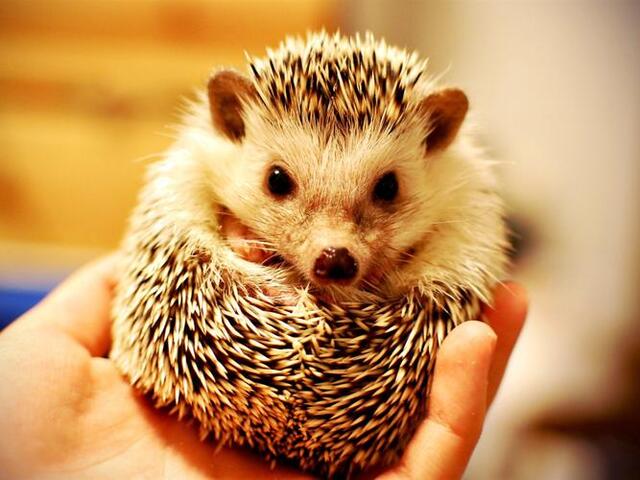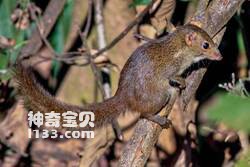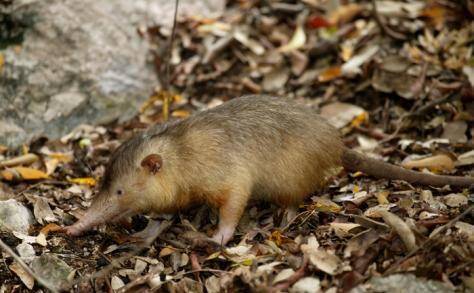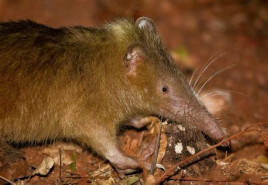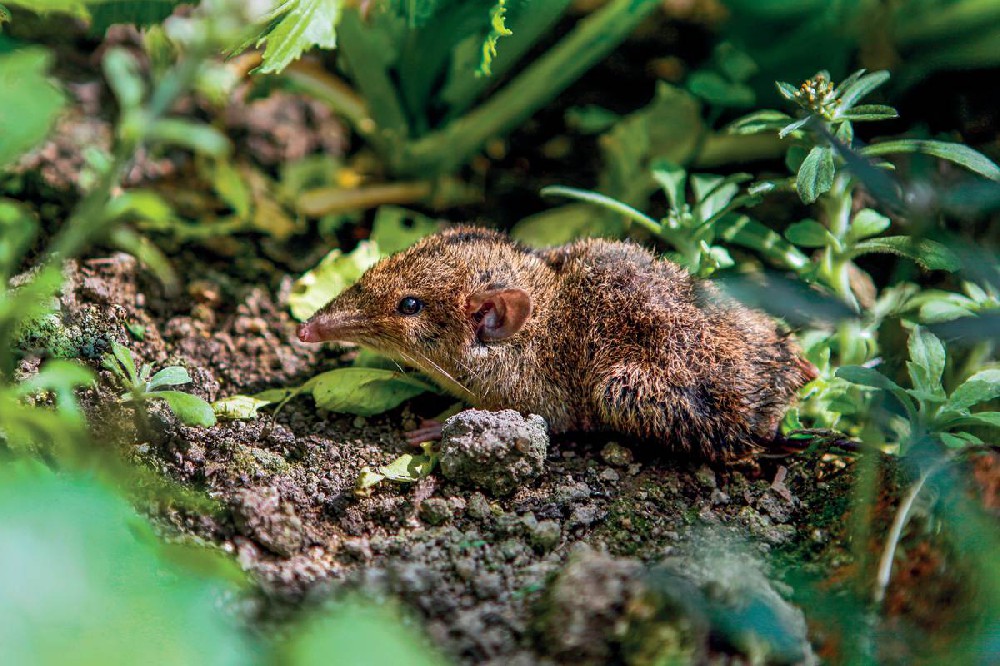kangaroo
IUCN
LCBasic Information
Scientific classification
- name:kangaroo
- Scientific Name:
- Outline:Eulipotyphla
- Family:Macropus Macropodidae Diprotodontia Marsupialia Mammalia
Vital signs
- length:1300~1500 mm
- Weight:2.5 to 100 kg
- lifetime:20 to 22 years
Feature
Pouch: Kangaroos are famous for the pouches possessed by females, a distinctive feature of the Kangaroo family. The pouch is located on the abdomen of a female kangaroo and is used to carry and raise her young.
Jumping Ability: Kangaroos are the highest and furthest jumping mammals. Their hind legs are powerful and capable of leaping at incredible speeds and heights.
Appearance characteristics: The kangaroo has a slender body, a small head, big eyes, long ears, and black whisker marks on both sides of its nostrils. Their tails are thick and thick, serving as a support when perching and as a balance when jumping.
Life habits: Kangaroos are herbivorous animals and mainly feed on grass and other plants. They like to gather in small groups, usually consisting of one male, multiple females and their cubs. Kangaroos have very sensitive senses of sight, hearing, and smell, which allow them to effectively avoid predators and find food in the wild.
Distribution and Habitat
They are mainly distributed in parts of the Australian mainland and Papua New Guinea. They have adapted to Australia's various natural environments, from cool rainforests, deserts, plains to tropical areas. Kangaroos' habitats usually include dry, sunny places that help maintain body temperature and moisture. There are many types of kangaroos, and different types of kangaroos live in various natural environments in Australia.
Appearance
Strong hind legs and tail: Kangaroos have strong hind legs adapted for jumping and locomotion. Their tails are not only strong, but also provide balance when jumping and support when perching.
Pouch: Female kangaroos have a front-opening pouch for carrying and feeding their young. After birth, the young crawl into their mother's pouch to continue to develop and grow.
Head features: Kangaroos have relatively small heads, but are very flexible. They have large ears and black whiskers on both sides of their nostrils, and their vision, hearing, and sense of smell are very sensitive.
Herbivorous: Kangaroos are herbivorous animals, mainly feeding on herbs, leaves, and bark. They have a special digestive system to process plant fibers.
Social behavior: Kangaroos usually live in groups and have a certain sense of territory. They express their intentions and emotions through special calls and gestures, forming a certain hierarchy.
Adaptability to multiple environmen
Details
Kangaroo (English: kangaroo, ganguro) is a mammal belonging to the genus Macropodidae, family Macropodidae, order Diprotodonta. The word "kangaroo" usually refers to the four largest species in the family Macropodidae, namely the red kangaroo, the eastern grey kangaroo, the western grey kangaroo and the antelope kangaroo. Kangaroos are native to Australia and New Guinea. They jump the highest and the farthest. Female kangaroos have a front-opening pouch, which is why they are named kangaroos. According to Australian government statistics, in 2019, there were 42.8 million kangaroos living in the four major economic regions of New South Wales, Queensland, South Australia and Western Australia, down from 53.2 million in 2013.
Kangaroos are a symbol of Australia and appear on Australian currency patterns. The green triangle kangaroo represents Australian manufacturing. The Qantas logo uses a flying kangaroo. Kangaroos have also become one of the animals on the Australian national emblem.
Morphological characteristics
Kangaroos are typical representatives of marsupials. Marsupials are incompletely developed animals and are premature fetuses, so they need to develop in the pouch. The mother kangaroo has four nipples, two high-fat and two low-fat. The mother kangaroo generally gives birth to 3 to 4 babies per litter. The kangaroos must enter the pouch immediately after birth and eat low-fat milk. This determines that only 2 kangaroos can survive in each litter; kangaroos are very small when they are born, about the size of a peanut. Adult kangaroos are 1.3 to 1.5 meters tall and can weigh up to 50 kilograms.
Kangaroos have small heads, big eyes, long ears, long faces, and black whisker marks on both sides of their nostrils. Kangaroos are timid and alert, and their vision, hearing, and smell are very sensitive. Kangaroos live by jumping. Their forelimbs are short and thin, which can be used to grab food. Their hind limbs are strong and their toes are merged. Their thick tails play a supporting role when they are perched and a balancing role when they jump. They jump with their lower limbs and run very fast, reaching a speed of more than 50 kilometers per hour. Kangaroos have a "multifunctional" tail that plays a very important role. When resting, it can support the ground and work together with the lower limbs to balance the body. When running, the tail is an important balance tool. In addition, the kangaroo's tail is an important weapon for attack and defense. Kangaroos like to gather in groups of 20 to 30. No matter how big they are, they have one thing in common: strong and powerful hind legs with long feet. The Crural Index (i.e. (calf length/thigh length) × 100 index, or (tibia length/femur length) × 100 index) of kangaroos reaches 172, and the red kangaroo reaches 202, far exceeding other animals, while the average human is only more than 80 [2]. Kangaroos jump instead of running, and can jump up to 4 meters and up to 13 meters. They can be said to be mammals with the highest and farthest jumps. Most kangaroos live on the ground, and they can easily be distinguished from other animals by the way they jump with their strong hind legs. Kangaroos use their tails to balance when jumping, and when they walk slowly, their tails can serve as a fifth leg. The kangaroo's tail is thick, long and full of muscle. It supports the kangaroo's body when it rests and helps it jump faster and farther when it jumps.
All female kangaroos, but males do not, have a front-opening pouch with four nipples. The "kids" or baby kangaroos are raised in the pouch until they can survive in the outside world.
Kangaroos and wallabies have large, elastic tendons in their hind feet. They store strain energy in them and use spring action to provide most of the energy consumed in jumping without excessive muscle effort. This is true for all animals that have elastic structures such as tendons connecting muscles to bones, but kangaroos are more efficient.
Jumping is closely related to breathing: when the hind foot leaves the ground, air is expelled from the lungs; just before landing, the hind foot moves forward and the lungs are re-inflated, increasing the energy efficiency of long-distance movement. Studies have shown that kangaroos and wallabies do not require any effort to accelerate beyond the minimum energy required for jumping, compared to animals such as horses, dogs or humans. Kangaroos' jumping is not conducive to escaping natural enemies. The upper limit of their jumping speed is not higher than other quadrupeds of similar size, and Australia's native predators are obviously not as strong as those in other regions. On the contrary, the advantage of jumping lies in the movement efficiency. In a barren and extremely changing environment, it is very important for them to be able to forage for food over long distances at a relatively high speed.
Habitat
Mainly distributed in grasslands and jungles in Oceania. Most kangaroos are endemic to Australia, but some tree kangaroos live on the island of New Guinea. Widely distributed in various regions of Oceania, from cold Tasmania to the arid and hot Northern Territory, from national parks to urban suburbs, kangaroos can be found.
Different species of kangaroos live in various natural environments. For example, the Portoroy kangaroo will make its own nest while the tree kangaroo lives in the bush. The large species of kangaroos prefer to use trees, caves and rock cracks as shelter.
"Kangaroo" refers to a paraphyletic group of species, just like "big kangaroo" and "small kangaroo". All three terms refer to members of the same taxonomic family, Macropodidae, and are distinguished by size. The largest species in the family are called "kangaroos", while the smallest are usually called "wallabies", with "macropods" referring to medium-sized species. There are also tree kangaroos, another form of the Macropodidae family, which inhabit the rainforests of New Guinea, northeastern Queensland, and some islands in the region. These kangaroos live in the branches higher up in the canopy. These informal terms give a rough idea of size:
Wallabies: About 45-105 cm long without the tail, with a tail length of about 33-75 cm. The small wood kangaroos (the smallest of all known macropods) are 46 cm long and weigh only 1.6 kg;
Tree kangaroos: From Lumholtz's tree kangaroos, males weigh 7.2 kg and females weigh 5.9 kg, and are about 48-65 cm long without the tail, with a tail length of about 60-74 cm. The gray tree kangaroo weighs about 8-15 kg and is 70-95 cm long.
Giant kangaroos: The black giant kangaroos (the smaller of the two species) have a tail length of 60-70 cm and stand 80 cm tall. Males weigh 19-22 kg and females 13 kg.
Kangaroos: Large male kangaroos can stand up to 2 meters and weigh 90 kg.
In order to eat grass, kangaroos have special teeth that are rare among mammals. Its incisors cut the grass, while the molars are responsible for chopping and grinding. Because the two sides of the lower jaw are not connected, the lower incisors are farther apart, allowing kangaroos to have a wider bite. Kangaroos' molars are ground by the silica contained in the grass, but before they finally fall out, the molars move forward in the mouth and are replaced by new teeth growing in the back of the mouth. This process is called polyphyodonty, and besides kangaroos, it is only found in Elephants-Are-Endangered.html">elephants and Manatees-Are-Endangered.html">manatees.
The origin of the English name of the kangaroo, "Kangaroo", is said to be that botanist Joseph Banks discovered a strange animal (Eastern Grey Kangaroo). He showed it to the Aboriginals and asked them about it. The Aboriginals did not understand English and answered "I don't know." (gangurru), so Banks misunderstood "gangurru" as the name of "kangaroo".
In 1819-1820, explorer Phillip Parker King studied in the Endeavour River area. He believed that the local word for kangaroo was "menuah" instead of "kangaroo", and "menuah" may also refer to another species of kangaroo. In 1898, anthropologist Walter Roth tried to correct this legend, but with little success. In 1972, linguist John B. Haviland believed in his study of the Guguimishe tribe that the local language "ganguruu" refers to a rare dark-colored large kangaroo.
The Kongouro from New Holland, George Stables, 1772, the first Western painting of a kangaroo
There are four species of kangaroos:
The red kangaroo (Osphranter rufus) is the largest living marsupial in the world and the largest mammal native to Australia. They usually inhabit arid and semi-arid areas, almost all of the Australian continent, except for the more fertile areas of rainforests on the southern, eastern and southeastern coasts of Western Australia and the northern coast. The highest density occurs in the pastures of western New South Wales. People often mistakenly think that the red kangaroo is the most numerous kangaroo species, but the eastern grey kangaroo is more numerous. Large male red kangaroos can stand up to 2 meters and weigh 90 kilograms.
The eastern grey kangaroo (Macropus giganteus) is less well-known than the red kangaroo outside of Australia, but is the most common because it is found in the most fertile eastern areas. The habitat extends from the top of Cape York Peninsula in northern Queensland to Victoria, southeastern Australia and Tasmania. In sparse woodlands, they live at a density of about 100 per square kilometer. In developed areas, such as farmland, there are fewer resources for them to survive, so the population size is smaller.
The Western Grey Kangaroo (Macropus fuliginosus) is slightly smaller than the Eastern Grey Kangaroo, with large males weighing about 54 kg. It is distributed in the southern part of Western Australia, near the coast of South Australia, and in the Murray-Darling Basin. The highest population density is in the western part of the Riverina region of New South Wales and the western part of the Nullarbor Plain. It is less distributed in human-inhabited areas such as agricultural areas. Because they are highly tolerant to the plant toxin sodium fluoroacetate, scientists believe that this species may have originated in southwestern Australia.
The antelope wallaby (Osphranter antilopinus) is the far northern counterpart of the eastern and western grey kangaroos. It is sometimes considered a kangaroo, but its behavior and habitat are more similar to kangaroos (red, eastern grey and western grey). The name comes from its fur, which is similar in color and texture to that of antelopes. To adapt to hot and humid regions and release more heat, male antelope wallaroos can adjust their nostrils to enlarge their nasal passages.
In addition to these, there are about 50 smaller species of kangaroos that are closely related to kangaroos. They and the cuscus family all originated from a common ancestor in the middle Miocene. This ancestor was probably arboreal and settled in the forest canopy that covered most of Australia at the time, eating leaves and plant stems, and the climate was more humid. From the late Miocene to the Pleistocene, the climate became drier, the area of forests decreased, and the area of grasslands expanded. During this period, kangaroos evolved larger bodies and adapted to low-nutrient herbivores, while developing the ability to ferment in the fore stomach to break down complex plant fibers and extract more nutritional value. The large groups of early kangaroos, the fanged kangaroos and the Bulungamayinae, became extinct about 5 to 10 million years ago in the late Miocene. [16] The relationship between the above two groups and kangaroos and rat-kangaroos is controversial. Some people argue that the fanged kangaroos are the ancestors of rat-kangaroos and the Bulungamayinae are the ancestors of kangaroos, while others hold the opposite view.
Ganguroo and Wanburoo of the late Miocene bulungamayines (subfamily) lack the first toe of the hind foot, and the second and third toes are reduced and partially attached to the larger fourth toe, similar to the foot structure of modern kangaroos, indicating that they walked bipedally. In addition, their ankle joints are not conducive to lateral movement, but are more conducive to jumping. Modern species such as gray kangaroos and giant kangaroos appeared in the Pliocene. The red kangaroo is probably the last of the branching species, with fossil records dating back only to the Pleistocene, about 1-2 million years ago.
Kangaroos and wallabies belong to the same taxonomic family (Macropodidae), and are often grouped together. The term "kangaroo" specifically refers to the four largest species in the family, while "wallaby" is an informal name for any species of the family that is smaller than a kangaroo or wallaby but is not specifically classified.
Movement
Kangaroos are the only large mammals alive today that use hopping on their legs as their primary mode of locomotion. Red kangaroos can comfortably hop at speeds of about 20-25 km/h, but can reach speeds of up to 70 km/h over short distances, and can maintain 40 km/h for nearly 2 km. When hopping, the powerful peroneus muscles are responsible for lifting the body off the ground, while the smaller plantaris muscles in the big toe provide the force for forward propulsion, with about 70% of the energy stored in the elastic tendons. When moving slowly, kangaroos use five legs to move, with the tail and forelimbs forming a tripod structure to support the body, and use the hind legs to move forward. Whether moving slowly or jumping at high speed, high energy must be consumed. The most energy-efficient is at medium speed, and kangaroos moving at speeds above 15 kilometers per hour are more able to maintain energy consistency than animals of the same size running at the same speed.
Diet
Kangaroos have only one stomach, unlike ruminants such as cattle and sheep, which have four stomachs. Although they sometimes regurgitate plants in their stomachs and chew them, and then swallow and digest them again, kangaroos chew more laboriously and do not occur frequently compared to general ruminants.
All species of kangaroos are herbivorous animals and also eat fungi, but each has a different diet. They live on short, green grasses close to the ground, and some species also eat leaves or small tree buds. The main diet of the eastern gray kangaroo is grass, which they eat a variety of types of grass, while other species, such as the red kangaroo, also include a lot of shrubs in their diet. Smaller kangaroos eat fungi underground. Many kangaroos are nocturnal and crepuscular, resting in the shade during the hot days and moving and feeding in the cool evenings, nights, and mornings.
No methane emissions
Methane (CH4) is produced by fermentation as a result of the slow digestion of cattle and other ruminants. When they burp and fart, the methane is released. Kangaroos emit almost no CH4, despite having a plant-based diet similar to these animals. The hydrogen byproduct of fermentation is converted into acetic acid in the body, providing energy for the body. Scientists are interested in transferring the bacteria that facilitate this process to cattle, as methane is about 23 times more effective than carbon dioxide in terms of greenhouse effect.
Kangaroos usually live in groups of 10 or more, and the group is effective in protecting weaker members. Group size and stability vary in different geographic regions, with groups in eastern Australia being larger and more stable than those in the arid west. Larger groups increase group cohesion and have more complex social structures, comparable to ungulates. A common behavior is nose-to-nose sniffing, which occurs mainly when individuals join a group. Kangaroos learn a lot from smell, and this behavior reinforces social cohesion. When sniffing each other, smaller kangaroos will lower their bodies to the ground and shake their heads, which may be a form of submission. Interactions between males and females are common, with larger males doing more. Other friendly interactions occur between a mother and her young, with grooming each other to strengthen their relationship, and mothers grooming their young during or after nursing. If a young kangaroo wants to enter its mother's pouch, it will gently rub its nose against it.
Kangaroos of all species can fight, sometimes briefly, and sometimes for a long time and in a ritualized manner. In cases where fighting is for competition, such as male kangaroos competing for females in estrus or for access to water, it does not last long. Both sexes fight for water, but prolonged and ritualized "boxing" usually occurs only between males. Smaller males are more likely to fight for females in estrus, and such fights are less common among larger males. Ritualized fights occur when male kangaroos graze together. Most fights are preceded by two males grooming and combing each other's fur with their paws or mouths. One or both assume a high stance, and then one challenges the other by grabbing the neck with its front paws. Sometimes the challenge is rejected, and large males often reject challenges from smaller males. In these fights, the combatants assume a high stance and grab the opponent's head, shoulders, and chest with their front paws. They also lock their forelimbs to push, wrestle, and use their tails for balance to kick the opponent's abdomen.
Short and long fights are similar except that there is no forelimb lock. The weaker party will kick more frequently to block the winning blow of the stronger party. The winner is revealed when one party breaks off the fight and retreats. The winner can push the opponent back or to the ground. The initiator of the fight wins more often, which helps them rise through the ranks among males. It has been found that the winner drives the loser out of the habitat, and the male kangaroos in the leadership class will pull up grass to intimidate other males.
Reproduction
The sexual behavior of kangaroos mainly consists of a pair. Kangaroos are viviparous and have no placenta. They mate and reproduce in 1-2 months. They give birth after 4-5 weeks of gestation. The cubs are only about 2.5 cm when they are born. Females in estrus will move around and attract the attention of males significantly. Males observe, track her movements and sniff her urine to determine if she is in estrus. This behavior shows the cleft lip sniffing response. Then, the male will slowly approach her to avoid scaring her. If the female does not run away, the male will continue to lick, touch and scratch, and then mate. After mating, the male will look for another female again and repeat the above process. Because it may take several days for two kangaroos to mate, and the mating process is also long, the female in the process of mate may attract the attention of competing males. Larger males tend to pair up with females that are close to estrus, while smaller males usually choose females that are far from estrus. Kangaroos that occupy a leading position in the group do not need to look for females to determine their estrus status. They can directly mate with females paired with the largest males without fighting.
The physiological structure of kangaroos can effectively adapt to dry, barren land and extremely changing climates. Since the female kangaroo has two uteruses, the baby in the right uterus has just been born, and the left uterus is pregnant with the embryo of the baby. After the kangaroo grows up and completely leaves the pouch, the embryo begins to develop. After about 40 days, it is born in the same way. In this way, the left and right uteruses take turns to get pregnant. If the external conditions are suitable, the mother kangaroo will continue to reproduce.
Kangaroos reproduce once or twice a year. The baby kangaroos are born about 30 to 40 days after fertilization. They are very small, blind, and have little hair. They are immediately placed in the mother kangaroo's pouch after birth. It is not until 6 to 7 months that they begin to leave the pouch for a short time to learn life. It will be one year before the baby is officially weaned and leaves the pouch, but it will still be active near the mother kangaroo, ready to get help and protection at any time. The mother kangaroo can have a baby kangaroo outside the pouch, a baby kangaroo inside the pouch, and a baby kangaroo waiting to be born.
When the baby kangaroo grows to four months old, its hair grows all over its body, its back is black-gray, and its belly is light gray, which looks pretty. When it is five months old, sometimes the baby kangaroo sticks its head out, and the mother kangaroo will press its head down. The baby kangaroo is getting more and more naughty. When its head is pressed down, it will stretch out its legs again, and sometimes even drag its little tail outside the pouch. Sometimes, such a big baby kangaroo will poop and pee in the pouch, and the mother kangaroo has to "clean" the pouch frequently: it uses its forelimbs to open the pouch, and uses its tongue to carefully lick the inside and outside of the pouch. After the baby kangaroo grows to seven months in the pouch, it begins to jump out of the pouch to move around. But if it is frightened, it will quickly get back into the pouch. At this time, the pouch becomes like a rubber bag, very elastic, and can be opened and closed, making it very convenient for the little kangaroo to get in and out.
Finally, the baby kangaroo grows too big to fit in the pouch, so it has to move outside. But it still has to rely on the mother's milk to survive, so it puts its head into the pouch to drink milk.
After three or four years, the kangaroo matures and becomes a large kangaroo with a height of 1.6 meters and a weight of more than 100 kilograms. At this time, its physical strength has reached its peak, and it can jump 65 kilometers per hour; a sweep of its tail can kill a person.
Female kangaroos usually continue to be pregnant, except on the day of delivery, in other words, they repeat the pregnancy cycle. Black-tailed kangaroos usually conceive one to two days before giving birth, and marsupials such as red kangaroos can mate and conceive a day after giving birth. In addition, she can control the development of the embryo to ensure that the kangaroo from the previous litter can leave the pouch independently. This is called embryonic diapause, which usually occurs during droughts or food-scarce areas. In addition, the composition of the mother's milk changes as the baby grows.
Males do not produce sperm during dry periods, and females can only conceive when there is sufficient rainfall and vegetation is growing.
Natural enemies
Kangaroos have some natural enemies. Paleontologists believe that the thylacine was once one of the main natural enemies of kangaroos, but it has become extinct. Other extinct natural enemies include marsupial lions, ancient monitor lizards and wonabi snakes. However, with the arrival of humans in Australia at least 50,000 years ago and the introduction of the dingo 5,000 years ago, kangaroos have had to adapt to a changing environment.
Along with the dingo, foxes, feral cats and dogs have also invaded Australia, posing a threat to the kangaroo population. Kangaroos and wallabies are good at swimming, and they will flee into the water to avoid pursuit; if the pursuer chases into the water, the kangaroo will try to push the pursuer under the water with its front paws and drown it. Another defensive strategy is to grab the natural enemy with the front paws and kick with the hind legs.
Diseases
Cases of kangaroos suffering from eye diseases are quite rare, but this disease is not a recent phenomenon. In 1994, the first case of blindness in kangaroos was reported in central New South Wales. The following year, cases were also found in Victoria and South Australia. By 1996, the virus had crossed the desert and spread to Western Australia. Authorities were concerned that the disease might spread to other livestock and even to humans. At the Australian Animal Health Laboratory, researchers detected Wallal virus in two midges, and less than 3% of kangaroos infected with the virus showed symptoms of blindness, so the two midges might be the spreaders of the virus.
Kangaroos mainly feed on young shrubs, grass and soft plants. In the process of kangaroos being raised in zoos, oral diseases are a common disease with high incidence and recurrence rates, which poses a great threat to kangaroos raised in zoos. In June 2003, a stomatitis syndrome characterized by swollen jaws, loose and falling teeth, and gingival erosion or ulcers was prevalent among the kangaroos in the Chengdu Wildlife Park in Sichuan. The kangaroos affected were of all sexes, breeds and ages, and the course of the disease was often chronic, with an incidence rate of 40% to 60% and a mortality rate of 60% to 100%.
Species classification
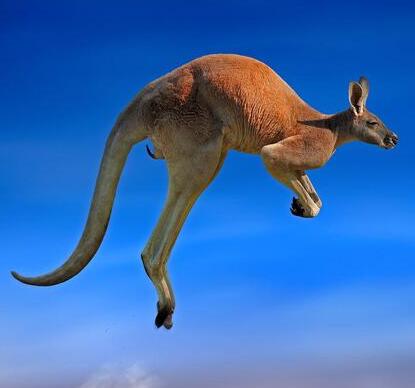
Red kangaroo
The most famous kangaroo is the red kangaroo, which lives in the dry areas of Australia, where the average annual rainfall is less than 500 mm. Since the kangaroo's food contains a lot of water, it can survive in areas without running water. In fact, only male red kangaroos are red, and female kangaroos are gray-blue, but under group breeding and hybridization, red female kangaroos have also appeared.
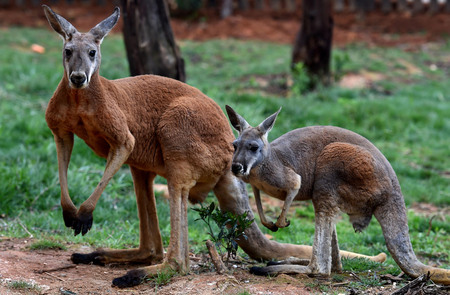
Red kangaroo
The red kangaroo, which lives in the open grasslands of southeastern Australia, is a marsupial and a representative species of kangaroos. It can be called the king of modern marsupials.
The red kangaroo looks like a mouse, like a giant rat. In fact, it has no kinship with mice. Its fur is reddish brown, its body length is 130 to 150 cm, its tail length is 120 to 130 cm, and its weight is 70 to 90 kg. It has a small head, a long face, and black whisker marks on both sides of its nostrils. It has big eyes and long ears. It has a strange appearance and is lovable. They have small heads, big ears, and big eyes. Adapted to the jumping lifestyle, the forelimbs are short and thin, which can be used to grab food, and the hind limbs are strong, with fused toes. It can jump 5 meters in one step and can reach a speed of 40 to 65 kilometers per hour. The tail is long and serves as a supporting organ when perching and a balancer when jumping.
Red kangaroos are mostly active in the morning and dusk, hiding in grass nests or shallow caves during the day. They like to gather in groups of 20 to 30 or 50 to 60 people, and mainly feed on plant food such as grass. It is timid and alert, with very sensitive vision, hearing and smell. Its long ears can hear the slightest sound, so it will slip away.
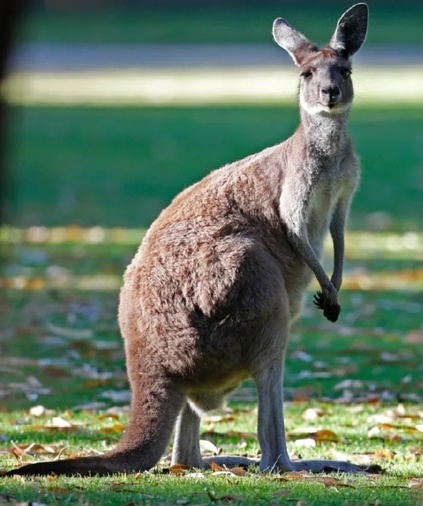
Eastern gray kangaroo
Although the Eastern gray kangaroo (Macropus giganteus) is not as famous as the red kangaroo, it is the most common. It lives in more fertile areas.
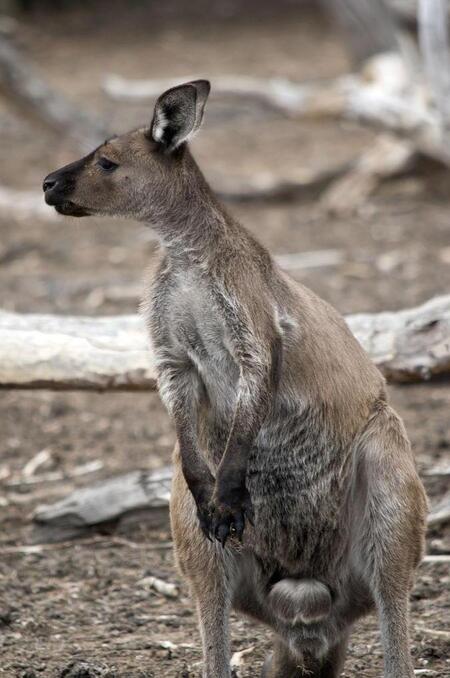
Western grey kangaroo
The western grey kangaroo (Macropus fuliginosus) is the smallest of the three kangaroos: an adult male weighs 54 kg (119 lb). It lives on the southwestern coast of Australia and the Darling River Basin.
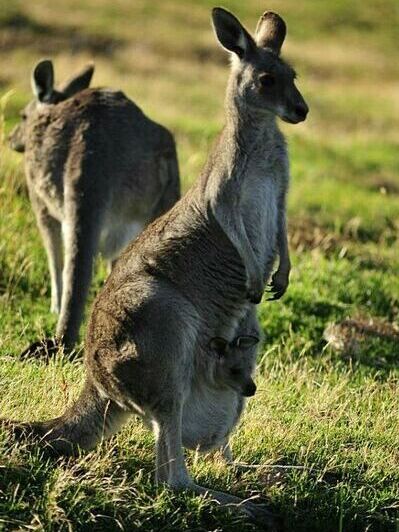
Musky kangaroo
With a body length of only 15 to 20 cm and a tail length of 12.7 to 15 cm, it is the smallest kangaroo in the world. Compared with the common kangaroos that hop on the grassland, they are typical dwarf species. They have lived in the rainforest for more than 20 million years. Scientists are very worried about their survival and believe that they are easily affected by environmental changes.

